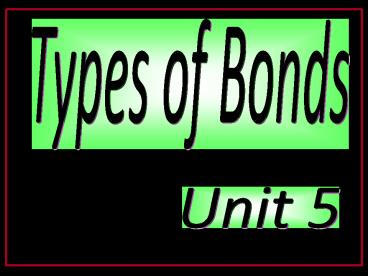Ionic Bonds - PowerPoint PPT Presentation
Title:
Ionic Bonds
Description:
Title: Ionic Bonds Author: CFISD Last modified by: Administrator Created Date: 10/17/2006 7:40:42 PM Document presentation format: On-screen Show (4:3) – PowerPoint PPT presentation
Number of Views:607
Avg rating:3.0/5.0
Title: Ionic Bonds
1
(No Transcript)
2
Why do Atoms Bond?
Valence electrons are involved in bonding.
3
What is a Chemical Bond?
The combining of atoms to form molecules or
compounds.
4
Types of Chemical Bonds
1. Ionic Bonds formed when atoms lose or gain e-
Atoms start off neutral. When they lose or gain
e-, they become ions.
IONS are charged atoms
Occurs between a METAL and a NONMETAL
5
Ionic BondsMetal to Nonmetal
19
Electrons either taken or given away
Sodium
Chlorine
Opposites attract
6
Losing Gaining Electrons
Metals form CATIONS ()
Give Away
Nonmetals form ANIONS (-)
Take in
7
Opposites Attract
The (-) ion and () ion attract.
(1)
(1-)
A neutral compound
8
Ionic Bonds
The Strongest wins the battle and loses the bone
(electron)
9
Ionic Bonds
An ionic bond is the resulting attraction for an
anion and a cation after an electron is
transferred from the metal to the non-metal
10
Types of Chemical Bonds
2. Covalent Bonds formed when atoms share e-
occurs b/t two nonmetals
Diatomic Molecules -atoms of the same element
share e-
BrINClHOF
11
Covalent Bonding
Dogs of equal strength
12
Covalent Bonds
A covalent bond exists when two electrons are
shared by two non-metallic atoms
13
Ionic or Covalent?
Ionic Bonds formed between a metal non-metal.
Covalent Bond formed between two non-metals.
14
Accounts for many physical characteristics
of metals, such as strength, malleability,
conduction of heat and electricity, etc.
Types of Chemical Bonds
3. Metallic Bonds formed when metals bond with
other metals. (sea of electrons)
15
Metallic Bonds
Mellow dogs with plenty of bones to go around !
16
Metallic Bonding
Metallic bonds are best characterized by the
phrase "a sea of electrons
17
A quick Review of Bonds
Ionic
Metal ()
Nonmetal (-)
Transfer of electrons creates ions that attract.
Nonmetal
Nonmetal
Covalent
The sharing of electrons creates. (BrINClHOF)
Metal
Metal
Metallic
Metal
Metal
electrons
Metal
All electrons are shared in a sea of electrons.

